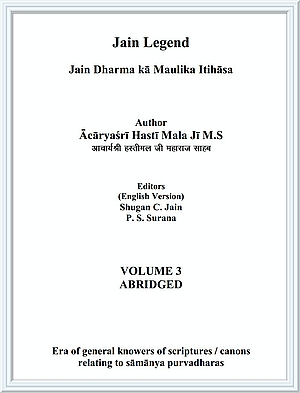During the first quarter of Vikram 7th century and V.N. 11th century, a great Ācārya, Delā Mahattara by name existed. He was the disciple of great propagator of Jainism, debater par excellence and scholar Ācārya Sūrā and teacher of Durgā Swāmī and Śrī Siddharṣi author of great spiritual text 'Upmiti Bhava Prapaṃca Kathā'. According to writings of Siddharṣi, he (Dela mahattara) was the Ācārya of Nivṛatti clan and an authority of his time in astrological sciences. Delā Mahattara wandered many times in Lāṭa Pradeśa and did great services to Jainism by teaching and preaching Jainism there to many people.
A great female monk scholar, Sādhvī Gaṇā was his disciple. She wrote the correct and beautiful first copy of the immortal religious text 'Upmiti Bhava Prapaṃca Kathā' authored by Siddharṣi.
In the end he died in Bhinnamāla by observing the rituals of pious death (saṃlleṃkhanā and saṃthārā).
Life sketches of the great Śaiva saints Tiru Jṅānasambandhara and Tiru Appara
The names of Tiru Jṅānasambandhara and Tiru Appara stand foremost amongst those who revived and re-established the Śaiva religion in southern India. Like they were the foremost saints for the revival and reestablishment of Śaiva religion in southern India, they are also considered as the foremost destroyers and fountainhead of the destruction of Jainism in southern India.
Jṅānasambandhara had been addressed as Jṅānasambandhara, Mūrtināyanāra and Jṅānasambandhara in Śaiva literature. His name i.e. as Pillai Nayanāra is also found in the literature. Pillai Nāyanāra was born in a Brahmin family of village Śiyālī in district Tanjaura.
To afflict mass conversion of Jains to Śaiva religion and to have mass killing of Jain monks in Madurā, he used to roam everywhere singing his poems to try and instigate hatred for Jainism and Buddhism amongst people.
Both Tiru Jṅānasambandhara and Tiru Appara were contemporaries. Combined efforts of these saints resulted in mass preaching of Śaiva religion in Tamilnadu. Tiru Appara, in the last part of his death and prior to his death gave up Śaiva religion and adopted Jainism again. He was the religious teacher of Pallavarāja Mahendra Varman-I, contemporary of Sundara Pāṇḍya. Prominent historian Dr A. Neelakaṃtha Śāstrī estimates the time of Pallavarāja Mahendra Varman-I as 600-630AD. This by itself proves the time of Jṅānasambandhara as first half of 7th century AD.
Life sketch of saint Tiru Appara
Being a follower of Jainism in his youth and as a ācārya of an important Jain maṭha, he became a Śaiva saint. Tiru Appara then became instrumental by undertaking several activities in destroying the prevailing mass influence of Jainism in Tamilnadu and replacing the same with Śaiva religion. Forever, his name will be mentioned with highest honours in Śaiva religion and with greatest disgust in Jain religion histories respectively.
We can easily estimate the power of his knowledge, personality by the sheer fact that he got the scholar, debater and expert of Jainism, Pallavarāja King Mahendra Varmana-I leave not only Jainism but adopt Śaiva religion and order inflicting of heavy casualties on followers of Jainism as per his will.
His other names found in both Jain and Śaiva literature are:
- Tiru Appara
- Appara
- Tiru Nābukasara
- Dharmasena
- Tiru Nābukasara Nāyanāra and Bāgīśa
Appara was converted from Jainism to Śaiva religion in the famous town of Tiruvāḍigāī. At the time when he was a Jain monk and the ācārya of Jain centre and maṭha of Pātalipurama, his name was Dharma Sena. Immediately after converting to Śaiva religion he destroyed the famous centre of Jain culture and temple and got a grand Śaiva temple named Tiruvāḍigāī in its place.
A significant aspect of Appara's life is that he was a distinguished Jainācārya first and then converted to Śaiva religion and took it to its pinnacle. In the end he again became a Jain monk and was murdered by his same Śaiva followers and companions to whom he helped achieve the highest positions.
 Acharya Hasti Mala
Acharya Hasti Mala
